ESP Machines
This machine was built to shuffle the famous Zener cards, aka ESP cards. That is the late Dr. Elizabeth McMahan in the picture.
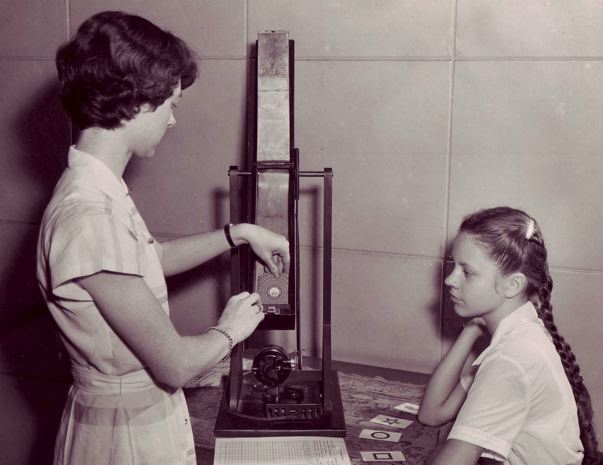
A blog about the Duke Parapsychology Laboratory.

This machine was built to shuffle the famous Zener cards, aka ESP cards. That is the late Dr. Elizabeth McMahan in the picture.

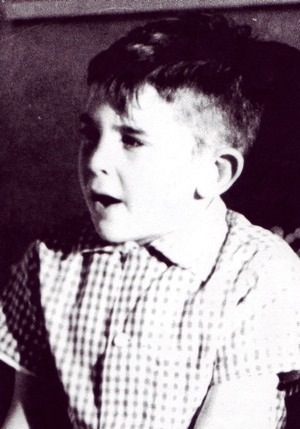
Once you start researching a story it’s hard to let go. I recently asked the librarians at the University of Central Arkansas Archives to search The Harold M. Sherman Papers for anything to due with Bruce Kremen, the missing boy I wrote about in Unbelievable. Bruce went missing in the Angeles National Forest in 1960, and Harold Sherman was one of the psychics the family contacted for help finding their son. A few things were in the collection and sent to me.
Among the materials was a picture of Bruce that I’d never seen (shown here), a few newspaper articles and letters, some hand written notes which I’m still trying to decipher, and two 1953 U.S. Department of Agriculture Forest Service maps of the region where Bruce went missing, which made me wonder if anyone who goes missing in there is ever found.
In one of the letters it was clear that the Kremens had broken off contact with Sherman. Harold had told them that their son had been murdered and in a letter he explained that “Mrs. Kremen has been threatened with a nervous breakdown and Mr. Kremen did not wish any adverse report to be given to his wife.” Completely understandable of course, but it looks like Harold was right, tragically. In the chapter about Bruce I talk about the fact that it is now believed that he was the victim of serial killer Mack Ray Edwards. Various law enforcement agencies are now looking at Edwards for Bruce and a number of other children who went missing. In fact, among the materials sent to me was an August 22, 1961 article about Karen Tompkins who had just gone missing. Sadly, every one of the children pictured are now believed to be victims of Edwards—in a couple cases they are known to be victims. Mack Ray Edwards confessed to some of the killings in 1970. (More below.)
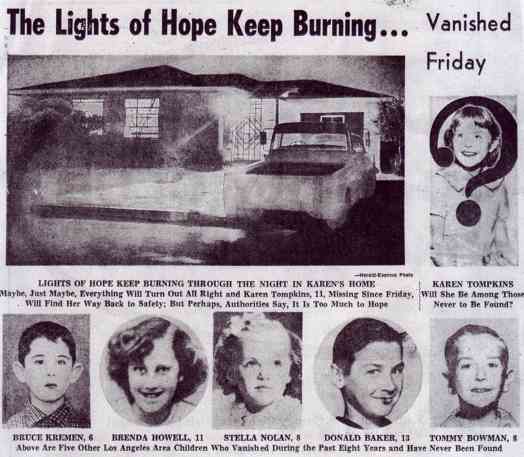
Reminiscent of all those years ago, law enforcement were under strict instructions not to contact Etta Kremen, who died on March 12, 2008, but to call her surviving son instead. It’s such a relentlessly sad story.
I’m still trying to decipher Harold’s hand writing, but he described the killer as short and barrel chested, and there’s something about a scar but I can’t read the details. And it looks like Harold was working with the FBI and not the Sheriff’s office, who according to Harold were not called about Bruce’s disappearance until 48 hours after Bruce went missing. Apparently officers did find the road that Harold had described and when they got there the scene was also as he had said (beer cans and other evidence that someone had spent some time there). Writer Weston DeWalt, who found the evidence that led to the new re-investigations, is still working on this story and I can’t wait to see what he comes up with and writes.
On a semi-related note, I have a few letters between Harold Sherman and J. B. Rhine about setting up a parapsychology department at the University of Arkansas. Sherman wrote J.B. to see if he or another member of the lab might be willing to leave Duke and establish a research center there because Sherman had reason to believe that the president of the university, Lewis Webster Jones, might be sympathetic to their work. Rhine was friendly and grateful, and while he doesn’t completely shut Harold down, it’s clear that it’s not likely he would leave Duke.
In July, 1936 Rhine went to California to investigate Pat Marquis, a 12-year-old boy who had been wowing everyone with his ESP abilities. Two years before the boy had gone into a trance and Napeji, an 11th century Persian, emerged. This was very reminiscent of Abdul Latif, the spirit of a seventeenth century Persian physician who sometimes appeared when medium Eileen Garrett went into a trance. Rhine had begun testing with Eileen Garrett in 1934.
So whenever Pat went into a trance, Napeji would take over, and while blindfolded, the boy/Napeji could supposedly tell you which cards had been picked from a deck, walk around, play pool and so on. Rhine traveled 3,000 miles only to show them that the boy had actually been peaking down his nose through the blindfold. “… I had the physicians blindfold me in the various ways the boy had been blindfolded,” Rhine wrote Mrs. Bolton, one of their contributors, “and I showed them to their satisfaction that I too could find my way about pretty well and could tell them how many fingers they held up, etc.“ (More below.)
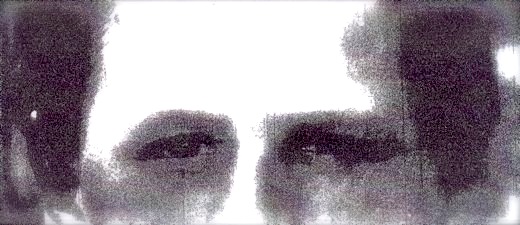
Rhine had a talk with Dr. Cecil Reynolds, the physician who had been managing the boy, and as far as Rhine was concerned, it all ended well. “… we managed to settle the whole thing in the most friendly and non-incriminating fashion,” he wrote Bolton, “and I left with the understanding that the Napeji personality (an ancient Persian) was not to be evoked again and the lad was to discontinue his pranks.”
I like that Rhine was never out to embarrass or humiliate anyone and always gave them the opportunity to just quietly stop and go away. He didn’t like to play the part of the debunker. Nevermind all the people already providing that service, he also wrote later, “I found that exposing these people did not put them out of business …” And that is just what happened here. Reynolds and the boy continued to put on performances and in April, 1937 Life Magazine did an article about Marquis.
Rhine wrote Bolton again. She must have asked why he didn’t go public with what he had found and Rhine had to explain. “It is not my policy to call anyone a fake,” he wrote, “and above all I regard it as bad taste to make such statements in public. The old physician in charge of the boy [Reynolds], when he saw through the whole case with me, agreed that it should not go on any longer, as did the boy himself. On my part I assured them that I had no intention of publishing anything on the case. I never have and do not intend to. Mr. Lewis Browne’s letter to the magazine LIFE, which was written after Dr. Reynold’s broke his agreement with me and published more claims for the boy (perhaps under the influence of the boy’s mother, who, a divorcee, was living in the same house as the divorced doctor at the time), was written without any knowledge or consent on my part …”

Lewis Browne must have made erroneous claims about either Rhine’s connection to the case, or his assessment. I still have to look up that letter to the editor. But I started looking into Dr. Reynolds. It turns out Reynolds was well known in the Los Angeles area. For almost two decades he regularly testified at some of the biggest criminal cases in California. Typically big murder cases that are forgotten now, but were front page news for months at the time. Like Marion Parker, the 12 year old daughter of a Los Angeles Banker who was abducted and dismembered in 1927 by William Hickman. Reynolds was usually called to testify about whether or not an alleged murderer was sane. Reynolds also had a history of being interested in the paranormal.
From here I found lots of interesting connections.
Reynolds was a close friend of Charlie Chaplin and he was also Chaplin’s personal physician. The doctor even had a bit part in Modern Times playing a minister. I think Reynolds must have been a bit stage-struck—he once worked as an un-credited medical consultant for the movie Frankenstein. Another interesting connection: apparently Chaplin invited Reynolds to be there when Einstein came to Chaplin’s house in 1931. Einstein was out West visiting the Mount Wilson Observatory where scientists had found evidence of cosmic background radiation, the first real proof that the universe was expanding. During this same visit out West Einstein attended a seance at Upton Sinclair’s house (I wrote about this in Unbelievable).

J. B. Rhine, who was a good friend of Upton Sinclair’s, had been introduced to Charlie Chaplin by Sinclair and had visited with Chaplain a number of times when he was out West. (Rhine also corresponded with Einstein.) On one occasion Chaplin showed Rhine a film he had of Pat Marquis.
Rhine’s description of another visit with Chaplin made me smile when I tried to imagine it. “When I was in Hollywood,” Rhine wrote, “Charlie Chaplin showed me a picture which he had taken in Bali and told me of another much better one which he offered to obtain for me from Singapore, picturing some of the religious ceremonial phenomena of self-torturing and allied behavior.” I could just see Rhine doing his best to say in the politest way possible, “no thank you.” (Rhine was on the conservative/straight-laced side, although I found exceptions to this which perhaps should be another post!)
Lewis Browne, who was mentioned in Rhine’s letter to Bolton, was a writer and part of Chaplin’s circle of friends, along with Hamlin Garland, another writer who was also very seriously interested in paranormal phenomena and who had met with Eileen Garrett during her first visit to the states in 1931. Rhine was introduced to Garland by Charlie Chaplin and Garland was the only one Rhine really kept in touch with out of this crew. I found a numbers of letters to and from Garland in the Special Collections Library at Duke.
Finally, I found out that Dr. Reynolds also met with Eileen Garrett during her 1931 visit. So Reynolds knew all about Eileen’s trances and her Persian spirit guide and could have either told those stories to Marquis or worse, coached him with them.
The first picture is of Pat Marquis from the April 19, 1937 issue of Life. The second picture is of Dr. Reynolds and I got it from Notables of the West, Press Reference Library (Western edition). I don’t think I need to identify the last picture!
In the early 1950’s, while he was working at the Duke Parapsychology Laboratory, Dr. Karlis Osis conducted two experiments with cats. I didn’t study these experiments, and what I know of them I got from Gaither Pratt’s book, Parapsychology: An Insider’s View of ESP. In the first experiment, the cat was offered two “equally attractive food pans,” while the experimenter, “screened from the cat’s sight, decided on some random basis which should be the ‘correct’ pan for each trial.” (More below.)
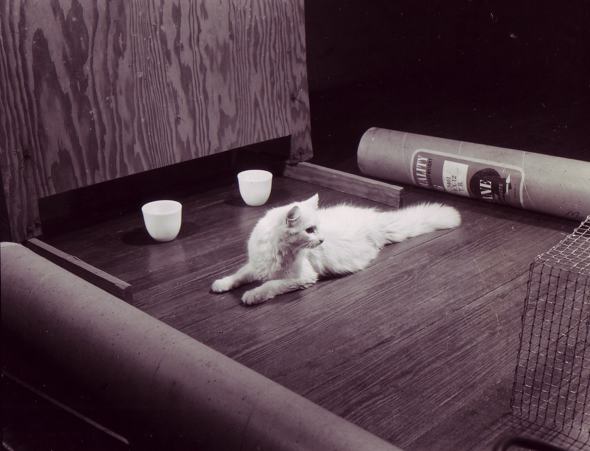
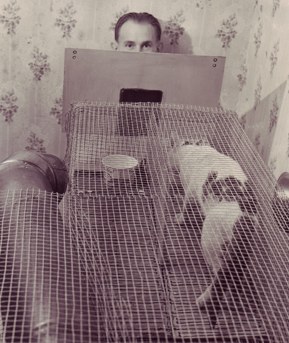
The experimenter (Osis) “concentrated upon having the cat make the same choice.” The results were “not spectacular,” but still better than chance. The problem was Osis couldn’t say whether it was ESP in the cats or “some essential psi element which the experimenter was contributing to the man-cat relationship.”
So they (Osis and Esther Bond) set up a second experiment, and this time neither experimenter knew the correct choice. One pan had food and one didn’t. A fan was installed to blow the scent of the food away. This experiment didn’t provide striking results either, in fact even less than the first experiment, but there was some evidence of ESP.
Not to be critical, but these experiments sound pretty crude today. I imagine better experiments could be conducted now. Rupert Sheldrake has done a lot of work with animals, which he has written about in his book, Dogs That Know When Their Owners Are Coming Home, And Other Unexplained Powers of Animals (1999).
I took some pictures of the ESP machines at the Rhine ESP/Parapsychology Museum at the Rhine Research Center and I can’t find all my notes! So I was thinking, that would be a little embarrassing, not being able to properly identify what they are. And that’s when I decided to make a contest out of it.
I will send a signed copy of my book to the first person who can explain what one or both of these machines are testing exactly and how! (If one person explains Machine 1 and a different person explains Machine 2, I will send a copy to each.)
Machine 1

Machine 2

The scientists at the Duke Parapsychology Laboratory pretty much tested every group they could think of for ESP. The picture below is from a series they did testing blind children. The caption reads: The subject is trying to match sealed ESP cards to key cards with raised symbols. Rhine’s conclusions from his book Frontier Science of the Mind:
“Groups of blind children have yielded results that compared with those of seeing children of the same age … while no group of any size has been found completely devoid of capacity to demonstrate ESP, at the same time no subdivision of the human species has been found to stand out in any really distinctive way as either possessing superior psi powers or superior control over them.”
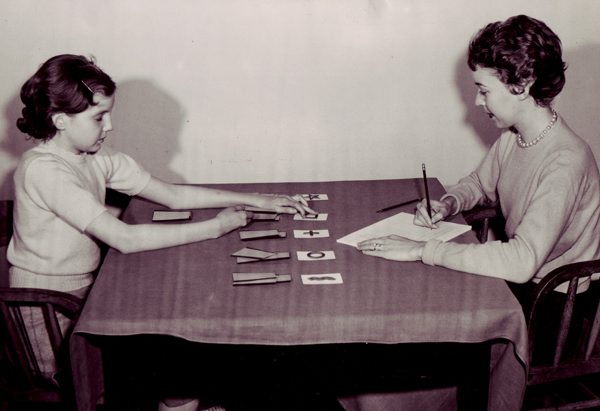
I have a geek side, I love machinery, and I’ve been collecting pictures of ESP machines. The machine below was designed by Helmut Schmidt, a German physicist who worked at Boeing’s research laboratory, and later for J. B. Rhine. From the caption that came with the photograph:
A recent development in the testing of precognition is the electronic machine shown. It emphasizes elements of fun and challenge to prevent build-up of emotional blocking mechanisms in the subject. The four lamps of different colors light up in different sequence: The subjects task is to predict which one will light next and push the corresponding button. The machine uses single quantum processes which may form nature’s most elementary source of randomness. And electronic counter that counts (at a rate of 10 to the 6th power per second) in the sequence 1,2,3,4 1…is stopped at the random time when an electron emitted by a radioactive source (strontium 90).
That is Helmut Schmidt in the photograph.